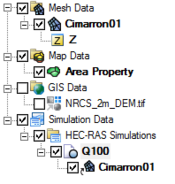SMS:HEC-RAS: Difference between revisions
No edit summary |
|||
| Line 102: | Line 102: | ||
[[Category:SMS Menus|HEC-RAS]] | [[Category:SMS Menus|HEC-RAS]] | ||
[[Category:External Links]] | [[Category:External Links]] | ||
[[Category:SMS 1D River]] | |||
Revision as of 14:37, 18 June 2019
The Hydrologic Engineering Center's River Analysis System (HEC-RAS) is a one- and two-dimensional model for computing water surface profiles for steady state or gradually varied flow. HEC-RAS supports networks of channels and is capable of modeling subcritical, supercritical, and mixed flow regime profiles. HEC-RAS is able to model obstructions in the flow path. Two dimensional capabilities were added to HEC-RAS 5.0 in 2016.
Historically, SMS and WMS have supported tools for creating and editing cross sections and attributes for these cross sections for one dimensional HEC-RAS 1D. These cross sections can be imported from the HEC-RAS system in the form of an SDF file (exported by HEC-Ras) and saved as a HEC-GeoRAS file for inclusion into a HEC-RAS project. The WMS package has also developed floodplain mapping tools to generate floodplains from HEC-RAS results.
With the 2D version of HEC-RAS, a new SMS interface to HEC-RAS has been added (starting with SMS 12.2). This new interface is a simulation-based interface that allows defining multiple simulations with individual settings in a single SMS project. All of the mesh generating options supported in the SMS may be used to generate/edit a grid for use in HEC-RAS 2D.
SMS continues to include tools for defining river networks and cross-sections.
The HEC-RAS model can be added to a paid edition of SMS.
HEC-RAS Simulation
Starting in SMS 12.2, HEC-RAS uses a simulation process. SMS can run multiple HEC-RAS simulations using the same components. To create a new simulation, right-click in the Project Explorer and select New Simulation | HEC-RAS. Components can then be linked to simulations by dragging the components under the simulation or by right-clicking on the component item and using the Link To submenu.
Components for the HEC-RAS simulation include the following:
- 2D Mesh
HEC-RAS Simulation Menu
Right-clicking on a HEC-RAS simulation provides a menu with the standard simulation menu commands and the following commands specific to HEC-RAS:
- Model Check – Launches the model checker to look for problems with the simulation setup.
- Export HEC-RAS – Exports the mesh geometry so it can be imported into HEC-RAS.
HEC-RAS Files
A HEC-RAS simulation in SMS will generate a number of files for use in the HEC-RAS program. The following files are generated:
- *.g01 – HEC-RAS geometry file.
- *.g01.hdf
- *.prj – The HEC-RAS projection file. For post-processsing, open this file in the HEC-RAS software.
- *_projection.prj – The projection/coordinate system used by the project in SMS.
HEC-RAS Troubleshooting
Starting in SMS 12.2, HEC-RAS uses the dynamic model interface. If HEC-RAS was purchased through Aquaveo, the DMI file and HEC-RAS library was included in the installation and should be available for use when starting SMS.
Currently, HEC-RAS will encounter a memory error when exporting a mesh that contains more than 500,000 elements.
HEC-RAS does not support voids in a mesh. Be certain to review the mesh for voids, holes, flat elements, and other irregularities before exporting.
Related Topics
External Links
SMS – Surface-water Modeling System | ||
|---|---|---|
| Modules: | 1D Grid • Cartesian Grid • Curvilinear Grid • GIS • Map • Mesh • Particle • Quadtree • Raster • Scatter • UGrid |  |
| General Models: | 3D Structure • FVCOM • Generic • PTM | |
| Coastal Models: | ADCIRC • BOUSS-2D • CGWAVE • CMS-Flow • CMS-Wave • GenCade • STWAVE • WAM | |
| Riverine/Estuarine Models: | AdH • HEC-RAS • HYDRO AS-2D • RMA2 • RMA4 • SRH-2D • TUFLOW • TUFLOW FV | |
| Aquaveo • SMS Tutorials • SMS Workflows | ||
